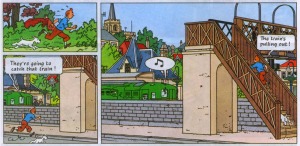
I recently had a conversation with someone about The Place Beyond the Pines in which I said that the film was the most upsetting I had seen in a long time. This person took this to mean I didn’t like the film when the exact opposite was true. I loved it.
Some people cannot comprehend why anyone would want to put themselves through such an experience, or indeed actively seek it out. An acquaintance once told me that he thought every story should have a happy ending. I countered that this was nonsense. How should The Godfather Part II end? Michael Corleone forgives his wife and Fredo, gives up organised crime and embarks on a legitimate olive oil business? Such a finale would be lunacy, and The Godfather Part II, obviously, is one of the most brilliant cinematic experiences out there.
I am interested in stories that scar, stories that make me feel something, and that doesn’t necessarily always mean feel something good. Hysterical laughter and triumphant exhilaration are not the only extremes to which I like to be taken. Being offended, terrified and even monumentally upset are equally valid and often profoundly cathartic responses to a story. Such a response makes me feel alive, and incidentally is one of the reasons I enjoy the horror genre.
How do I explain this supposedly peculiar personality trait to those who don’t relate to what I’m saying? I think Sally Sparrow said it best in the terrific Doctor Who episode Blink. When challenged by a friend who didn’t understand her penchant for abandoned, empty houses, Sally said she liked them because they were sad, and that “sad is happy for deep people”.

I don’t think I’ve ever heard my penchant for all things melancholy summed up so perfectly. On many occasions I have defended my taste for such things in all artistic fields (for example, one of the many things I love about pop group Pet Shop Boys is the way they have such downbeat lyrics to such up tempo music). I remember another conversation I had with someone who found The Remains of the Day (the book and the film) depressing – not because of the beautiful, poignant insights it contains into the tragedy of wasted lives, but because it had no car chases, no sex, no violence, and an unhappy ending.
On a related note, I am often struck by how much tragedy the Bible contains. For instance, Samson is one of my favourite stories ever. It is deeply, deeply moving and I want someone in Hollywood to make a proper film of it.
I wouldn’t go so far as to claim the reverse of Sally Sparrow’s assertion (ie happy is happy for shallow people), but I remain perplexed and baffled at why some individuals seem unable to appreciate tragic art. Generally I find those who have been through difficult or traumatic experiences are not that way inclined (for example, Holocaust survivors do not avoid dark or downbeat stories). Rather, it seems to be individuals who have been through no significant problems in life that are unwilling to engage with such material. Perhaps what lies at the root of this is fear – a subconscious burying-head-in-sand refusal to acknowledge that life can be pretty tough at times.
Obviously, what I have just said is a gross generalisation. All people are different, and if you don’t like tragedy then fair enough. Nevertheless, I believe what I have said has a grain of truth. Stories that are genuine and honest but upsetting allow us to come to terms with or perhaps occasionally make sense of the absurdities and cruelties of our existence.
I must be honest and admit that a couple of people who have read my upcoming novel Children of the Folded Valley found it “desperately sad”. But they meant that as a compliment. Perhaps for them sad is happy for deep people. Incidentally, I disagree with this particular verdict. I don’t think Children of the Folded Valley is desperately sad, although there are certainly upsetting scenes in it. My intention was for it to have an undercurrent of hope, but obviously readers will ultimately judge whether I was successful or not.











